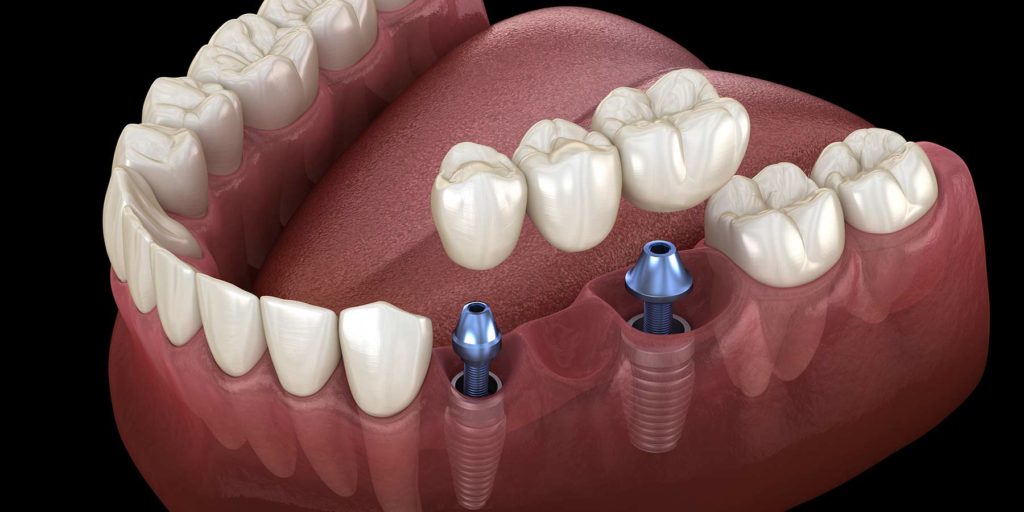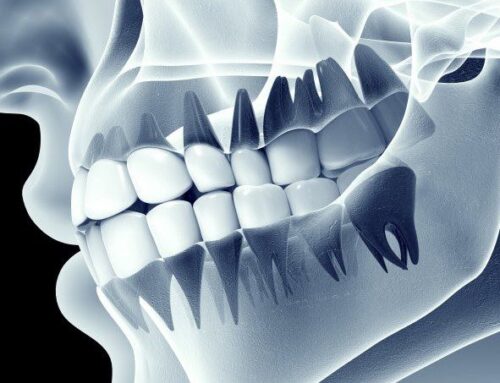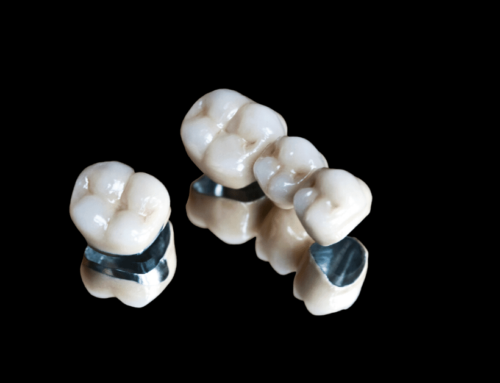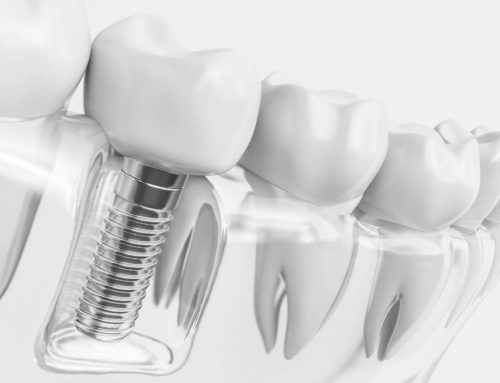A Bridge to a Better Smile
Our adult teeth don’t always last a lifetime, which means most of us will eventually lose a tooth – or a few, as time marches on. While living with a gap in your smile can be tolerable, depending on where the missing teeth land, their absence can cause other problems, such as irregular tooth wear, difficulty chewing and even more serious issues, such as shifting teeth or jaw pain and tension.
When several teeth are missing, the shape of the mouth and ultimately, the face, can change dramatically. The most common solution to replace missing teeth is a bridge, but not all bridges are the same. Regardless of which type your dentist recommends, installing a dental bridge is a specialized procedure resulting in varying degrees of discomfort, depending on which type is used. If you have any hesitation or questions before agreeing to proceed, let your dentist know and they should be able to address your concerns. But before you ask the obvious questions, we’ve compiled what you need to know about dental bridges.
What is a Dental Bridge?
A bridge consists of artificial teeth (“pontic” teeth), either temporarily or permanently secured to your natural “abutment” teeth, unless an implant is required. What material is used and how the bridge is secured in the mouth can vary, and often depends on the condition of the existing teeth. In cases where gum disease is a factor, or when there are not healthy teeth to support the bridge, your dentist may recommend dental implants. This choice will also depend on your overall health; if a patient is immune-compromised, dental implants are not recommended due to the risk of infection.
Regardless of which type of bridge you choose, the process of fitting and installing a bridge will require several appointments, first, to prepare the anchor teeth or install implant bases, and later, replacing a temporary bridge with the specially fitted, fully functional bridge. In most cases, the visible difference between your natural teeth and the artificial replacements will be barely noticeable, but your smile and the function of your mouth will be transformed. Even speech problems caused by missing teeth can be corrected with a well-fitted bridge.
An implant-supported bridge is the most expensive option, but unlike other bridges, this is considered to be a permanent solution; other types of bridges may need to be replaced in five to 15 years, depending on dental hygiene and the general condition of the mouth. Cost also will be affected by how many teeth are being replaced, placement in the mouth and other factors, such as what material the artificial tooth is composed of. Typically, the pontic teeth are made of porcelain or ceramic, but a gold alloy is sometimes used because it is a durable option (its use in dental work dates back thousands of years).
Implant Supported Bridges
Most often, an artificial tooth (or several) is incorporated between two crowns that are designed to fit over the existing teeth on each side of the gap. The dentist will file down the healthy teeth that will anchor the bridge to prepare them for the attachment. There are a variety of permanent bridges to choose from, including those that are secured by dental implants; temporary bridges need to be removed and cleaned daily, but the tradeoff is a lower cost and no requirement for surgery. But if the adjacent teeth aren’t healthy enough to support a crown, your dentist will insist on dental implants.
Dental implants are secured in the mouth by artificial “roots” made of titanium that are surgically fused into the jawbone. For patients with multiple missing teeth or issues with gum disease, this is usually the necessary choice; an entire row of teeth can be replaced with this method, which is often preferred over wearing dentures because of the aesthetic and practical benefits of having a “permanent” set of teeth. A dental bridge with multiple teeth is supported by an implant at each end, so there is not excessive surgery required.
Still, installing dental implants is a serious procedure. Healing can take six to 12 weeks, and sometimes longer, so be prepared to adjust your schedule to accommodate a comfortable recovery. As with any dental surgery, it’s important to monitor your mouth, choose softer foods and avoid tobacco products while healing after a procedure. Any signs of fever, nausea or other issues should be reported to your dentist as they arise; infection is not always obvious until after it reaches the bloodstream, so it’s best to be vigilant at the first signs of illness. Your dentist might recommend antibiotics as a preventative measure before proceeding with surgery.
After installing the anchors, the dentist will make a mold of your mouth which is used to customize the artificial teeth to fit the available space. While you wait for the bridge to be completed and installed, your dentist will provide a temporary bridge to protect the area. If you’ve chosen an implant-based bridge, the process from start to finish is more complicated and may take months to complete. Once the implants are fully healed, your new teeth can be installed. While dental implants are much more intensive than the other types of bridges, the benefit is a new smile that should last a lifetime, with proper care.
Other Types of Bridges
Sometimes a “cantilever” bridge is used, in which case only one side of the bridge is secured to a filed-down anchor tooth. As a result of only having one support, this type of bridge is more susceptible to loosening, but with regular checkups, your dentist can ensure that it stays in place.
A “Maryland” bridge is often used to replace teeth in the front of the mouth. It consists of resin-bonded artificial teeth secured by metal bands that are cemented to the back of the anchoring teeth. This method doesn’t require filing teeth or any surgical intervention, so it’s a preferred option for any patient who is not in optimal health; anesthesia is usually not needed for this procedure. These bridges can last decades, but care should be taken to carefully clean the area where the artificial tooth is attached, otherwise it can become a hotspot for decay. Because this type of bridge isn’t secured by using crowns, a Maryland bridge is not as durable under biting pressure, so it’s rarely used for the back of the mouth.
Like any other part of your mouth, a bridge needs to be cleaned daily to prevent decay and infection. Brushing and flossing twice a day is always recommended. Ask your dentist for tips to maintain your bridge, and they can provide flossing instructions to assist with reducing tooth decay and preventing the development of gum disease.
After the procedure is completed and the bridge is installed, it may take time to adjust to your new dental prosthetic. If there is increasing tenderness or swelling for more than a few days after the work is completed, let your dentist know. Avoiding hard, chewy or sticky foods is recommended since they can loosen non-implanted bridges, but especially in the first few weeks of wearing your new bridge, you’ll want to be extra careful with eating until you’re used to the feeling of your new teeth. Sugary and acidic items also should be avoided to prevent decay, no matter which type of bridge you have.
Caring for a Removable Bridge
Although the cost is competitive, a removable bridge requires a lot more maintenance than a permanent bridge. It needs to be removed and cleaned daily, which means using a soft-bristle toothbrush, denture cleaner and cool water to scrub every surface. Don’t use hot water because it can warp the bridge. It’s also very important to make sure you don’t drop or damage the bridge while it’s being cleaned, so place a soft towel or washcloth underneath the cleaning area. Your dentist can provide instructions to assist with removing and replacing the bridge; it will take some practice and be careful not to bite down on the crowns while fitting into your mouth because the pressure can damage or even break the crowns. For comfort, you may want to remove the bridge while sleeping. It may take time to get used to the way it feels, but a removable bridge can be a convenient way to fill the gaps in your mouth on a budget.
Potential Complications
Aside from the risk of infection with implants, there are other situations that can arise and need attention.
- Pain while chewing and tooth sensitivity: It can take a while to adjust to the new bridge, and your teeth may feel tender for a while. If the discomfort doesn’t decrease, inform your dentist.
- Imperfect fit: This can lead to tooth decay under the crown, or slippage while eating, etc. If there seem to be problems with the fit or the bridge seems loose, let your dentist know as soon as possible so the fit can be adjusted appropriately.
- Decay: As the bridge ages, it might lose structural integrity and some areas could be prone to decay, especially the anchor teeth, which had layers of enamel removed to make space for the crowns to fit on top. The cement that bonds the bridge to the anchor teeth may eventually degrade, but in many cases, the dental prosthetic can be easily reattached.
Dental Bridges: Takeaway
Your dentist can discuss what you can afford and recommend the best solution if you’re considering a bridge. It isn’t just about making your smile look better – it’s a procedure that will improve the function of your mouth and protect your healthy teeth from additional wear and tear. Putting off an investment in your dental health can end up costing you more in the long run.
Call to book your no-obligation consultation today regarding dental crowns and let’s talk about what’s best for you.
Free Initial Consultation
Free consultations for all dental implants, bridges & crowns, braces, gum recession and full mouth reconstructions ($300 Value).
Contact us to book your appointment today.










